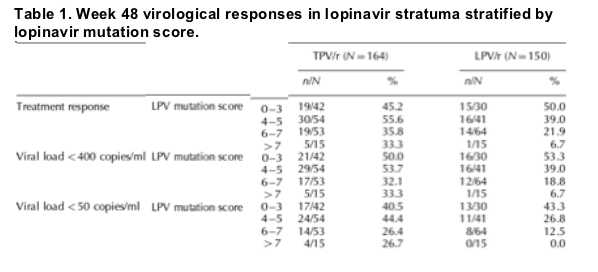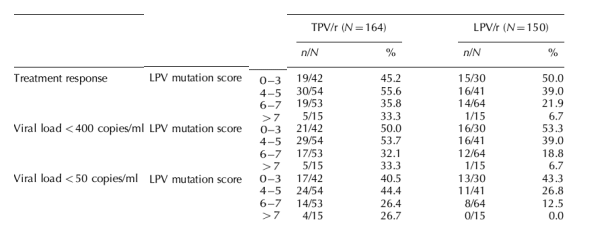| |
Treatment response to ritonavir-boosted tipranavir versus ritonavir-boosted lopinavir in HIV-1 patients with higher lopinavir mutation scores
[Research Letters]
|
| |
| |
AIDS:Volume 21(16)October 2007p 2245-2248
Walmsley, Sharon La; Cotte, Laurentb; Rusconi, Stefanoc; Ward, Douglas Jd; Hicks, Charles Be; Meier, Ulrichf; Valdez, Hernang; Boucher, Charles ABh
aToronto General Hospital, University of Toronto, Toronto, Canada
bHopital de l'Hotel-Dieu, Lyon, France
cSezione di Malattie Infettive e Immunopatologia, Dipartimento di Scienze Cliniche 'Luigi Sacco', Universita degli Studi, Milan, Italy
dDupont Circle Physicians Group, Washington, DC, USA
eDuke University Medical Center, Durham, North Carolina, USA
fBoehringer Ingelheim Pharmaceuticals GmbH and Co. KG, Ingelheim am Rhein, Germany
gBoehringer Ingelheim Pharmaceuticals Inc., Ridgefield, Connecticut, USA
hDepartment of Medical Microbiology Utrecht University, Utrecht, The Netherlands.
Abstract
Week 48 HIV-RNA treatment response to the protease inhibitor tipranavir co-administered with ritonavir was compared with that of lopinavir co-administered with ritonavir in patients whose baseline isolates had varying lopinavir genotypic mutation scores. With increasing lopinavir mutation scores, the proportion of patients achieving a week 48 treatment response was increased in the tipranavir/ritonavir compared with the lopinavir/ritonavir arm. Tipranavir/ritonavir therapy improves treatment response rates compared with lopinavir/ritonavir in patients whose viruses have reduced susceptibility to lopinavir/ritonavir.
Tipranavir (Aptivus) is a non-peptidic, protease inhibitor with potent in vitro activity against the majority of protease inhibitor-resistant HIV-1 strains [1-4]. Low-dose ritonavir is co-administered with tipranavir to ensure that therapeutic levels of tipranavir are achieved [5,6]. Tipranavir/ritonavir has potent activity against HIV-1 in treatment-naive [7] and treatment-experienced patients [8]. In patients who have previously received two or more protease inhibitor-based regimens, tipranavir/ritonavir is effective and well tolerated [8-10].
The RESIST-1 and -2 studies are multicenter, open-label phase III trials evaluating the efficacy and safety of tipranavir/ritonavir (500 mg/200 mg twice a day) compared with an investigator-selected, ritonavir-boosted comparator protease inhibitor (CPI) chosen from amprenavir/ritonavir, indinavir/ritonavir, lopinavir/ritonavir, and saquinavir/ritonavir. These were administered with an optimized background regimen (OBR), including two or more reverse transcriptase inhibitors, with or without the HIV-1 fusion inhibitor enfuvirtide, in triple-class antiretroviral therapy-experienced HIV-1-infected patients [8]. The trials were designed to have at least a triple combination antiretroviral regimen. The most appropriate CPI/ritonavir and OBR were selected for each patient by the investigator guided by resistance testing, before the 1: 1 random assignment of 1483 patients into the tipranavir/ritonavir and CPI/ritonavir groups. Antiviral resistance expert input was available to assist with the choice of OBR and the best possible CPI/ritonavir.
The study designs of RESIST-1 and -2 were similar allowing data from both trials to be combined for analysis. Tipranavir/ritonavir gave superior and more durable virological and immunological responses than CPI/ritonavir at weeks 24, 48 and 96 of the RESIST studies [8,11,12].
In a subanalysis of RESIST data, the week 48 HIV-RNA treatment responses to tipranavir/ritonavir and to lopinavir/ritonavir were compared in patients whose baseline isolates had different lopinavir genotypic mutation scores to identify the impact of this score on the virological activity of lopinavir/ritonavir compared with tipranavir/ritonavir. The lopinavir mutation score previously described and validated was derived by totaling the number of the following lopinavir-associated genotype mutations present: L10F/I/R/V, K20M/R, L24I, M46I/L, F53L, I54L/T/V, L63P, A71I/L/T/V, V82A/F/T, I84V, and L90M [13]. The lopinavir mutation score may be useful in interpreting HIV genotypic resistance testing with respect to lopinavir/ritonavir-based regimens [13].
Treatment response rates (confirmed viral load reduction ≥ 1 log10 copies/ml at week 48 without viral rebound; confirmed viral load < 1 log10 copies/ml below baseline), and the proportion of patients with viral loads less than 400 and less than 50 copies/ml at week 48 were determined for patients not taking lopinavir/ritonavir at screening and randomly assigned to receive either tipranavir/ritonavir or lopinavir/ritonavir. Genotypic sensitivity scores (GSS) for background drugs in the regimen were compiled. GSS represents the sum of genotypically sensitive background drugs in the regimen, with higher scores indicating the presence of more active drugs.
Of the lopinavir/ritonavir stratum patients for whom lopinavir/ritonavir was not in use at screening, 164 were randomly assigned to tipranavir/ritonavir and 150 to lopinavir/ritonavir. Baseline characteristics were similar in both treatment arms of the lopinavir/ritonavir stratum. For the tipranavir/ritonavir arm, the median baseline characteristics were 181 CD4 cells/ml, viral load 4.53 log10 copies/ml, and a lopinavir mutation score of five. For the lopinavir/ritonavir arm, the median baseline characteristics were 140 CD4 cells/ml, viral load 4.71 log10 copies/ml, and a lopinavir mutation score of six.
At baseline, phenotypic data were available for 75 isolates. The median fold changes in IC50 to tipranavir were 0.7, 1.9, 1.9 and 2.7 if the lopinavir scores were up to three, four to five, six to seven and more than seven, respectively. The fold change in IC50 to lopinavir was 1.4, 17.8, 41.3 and 94.5 if the lopinavir scores were up to three, four to five, six to seven and more than seven, respectively. Lopinavir clinical phenotypic cut-offs were less than 10-fold, greater than 10 and less than 40-fold and 40-fold and greater. Tipranavir clinical phenotypic cut-offs were between zero and three-fold, between more than three and 10-fold and greater than 10-fold.
International AIDS Society treatment guidelines emphasize the goal of sustained viral suppression to less than 50 copies/ml with newer antiretroviral agents, even in treatment-experienced HIV-1 patients [14]. With this efficacy endpoint in mind, a viral load less than 50 copies/ml was evaluated. In patients with up to three lopinavir mutations, the proportion of patients achieving a viral load less than 50 copies/ml was comparable between the two treatment arms (Table 1). For patients with a lopinavir mutation score greater than three, the proportion with a viral load less than 50 copies/ml was consistently higher in the tipranavir/ritonavir arm compared with the lopinavir/ritonavir arm. The most pronounced difference in viral suppression was observed at the highest lopinavir mutation score (more than seven), with 26.7% versus 0% of patients achieving a viral load less than 50 copies/ml in the tipranavir/ritonavir and lopinavir/ritonavir arms, respectively.


GSS for background reverse transcriptase inhibitors and enfuvirtide were compared for patients taking tipranavir/ritonavir or lopinavir/ritonavir, stratified by the lopinavir mutation score. The percentage of patients with enfuvirtide in the OBR was similar in each group (23.2% of tipranavir/ritonavir recipients and 22.0% of lopinavir/ritonavir recipients). The median GSS was two in all groups, except for patients in the tipranavir/ritonavir group with a lopinavir score greater than seven, when it was one. There were no significant differences between the groups for GSS, suggesting that the availability of active background drugs was similar for patients in both treatment groups. Therefore, it is unlikely that the more favorable responses observed in tipranavir/ritonavir recipients were the result of a more active OBR. If GSS scores are assessed according to response, non-responders in both the tipranavir/ritonavir and lopinavir/ritonavir groups had a similar number of patients with low GSS scores, whereas among responders in both the tipranavir/ritonavir and lopinavir/ritonavir groups the majority of patients had higher GSS scores.
Forty-eight week efficacy data from the RESIST trials has demonstrated that, for patients not taking lopinavir/ritonavir at screening, the proportion of patients who achieved a viral load less than 50 copies/ml in the tipranavir/ritonavir arm was greater than in the lopinavir/ritonavir arm [8]. Tipranavir/ritonavir represents an attractive treatment option in combination with an OBR for highly treatment-experienced patients [8]. Furthermore, in the patients whose baseline isolates were interpreted as having genotypic susceptibility to lopinavir despite having more than three lopinavir score mutations, virological responses were superior in the tipranavir/ritonavir arm compared with the lopinavir/ritonavir arm. Of the patients who were infected with virus with a reduced phenotypic susceptibility to lopinavir/ritonavir (all with more than three lopinavir score mutations), the proportions that achieved viral loads less than 50 copies/ml were consistently higher in the tipranavir/ritonavir arm compared with the lopinavir/ritonavir arm. Patients on treatment who experience persistent low-level viremia are at an increased risk of virological failure, emphasizing the need to optimize treatment and maintain an undetectable viral load of less than 50 copies/ml [15-17]. Tipranavir/ritonavir demonstrates the ability to achieve a sustained viral suppression to less than 50 copies/ml in many patients with reduced susceptibility to lopinavir.
Recent guidelines recommend that the main goal of therapy should be the suppression of viremia below detection limits even in treatment-experienced patients [8,14]. The results of this study suggest that tipranavir/ritonavir has the potential to achieve these recommended outcomes, particularly in patients whose HIV-1 isolates demonstrate reduced susceptibility to lopinavir/ritonavir.
Sponsorship: RESIST-1 and RESIST-2 were supported by funding from Boehringer Ingelheim Pharmaceuticals Inc. S.L.W. has career support from the Ontario HIV Treatment Network.
Conflicts of interest: S.L.W. is a consultant on advisory boards, speaker bureaus, and has participated in the conduct of clinical trials with Boehringer Ingelheim, Roche, Abbott, Bristol-Myers Squibb (BMS), GlaxoSmithKline (GSK), Gilead, Tibotec, Merck, Pfizer, and Agouron. L.C. is a consultant on advisory boards for BMS, Boehringer Ingelheim, GSK and Roche and has participated in clinical trials for Abbott, Boehringer Ingelheim, BMS, Gilead, GSK, Merck, Pfizer, Roche and Tibotec. S.R. has received research support or honoraria from Abbott, Boehringer Ingelheim, BMS, Gilead and GSK. He has also served as a consultant to Abbott, Gilead, GSK and Janssen-Cilag. D.J.W. is a consultant to, serves as a speaker, and has research grants from BMS, Boehinger Ingelheim, Gilead, GSK, Roche and Tibotec, and has research grants from Merck, Pharmasset and Tanox. C.B.H. is not an employee or a shareholder of stock in any company and has grant support from Abbott, Boehringer Ingelheim, BMS, Gilead, GSK, Tibotec, Merck, and Pfizer. He has served as a speaker for, an advisor to and received honoraria from Abbott, Boehringer Ingelheim, BMS, Gilead, GSK, Tibotec, Pfizer, and Roche. U.M. and H.V. were both employees of Boehringer Ingelheim. C.A.B.B. is consultant for Abbott, Roche, BMS, Glaxo Wellcome, and Boehringer Ingelheim.
|
|
| |
| |
|
|
|